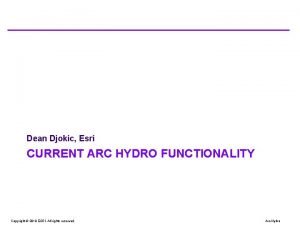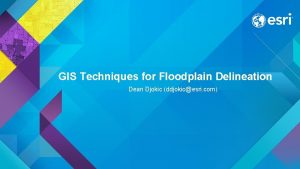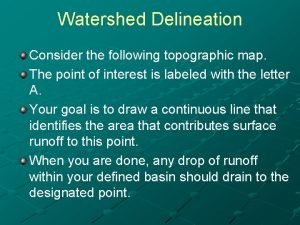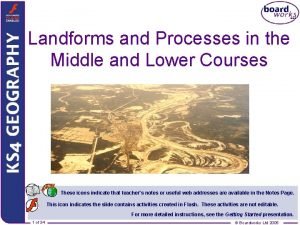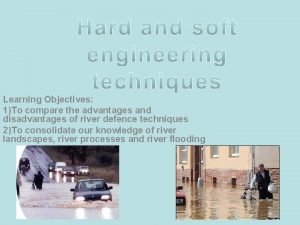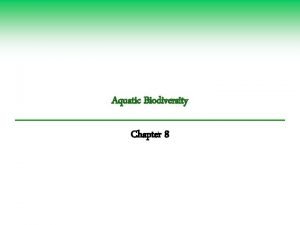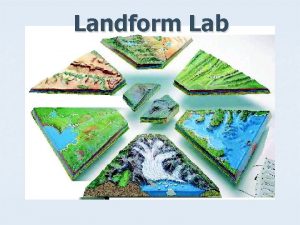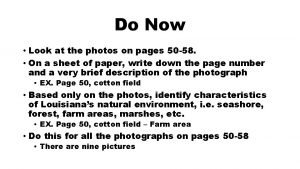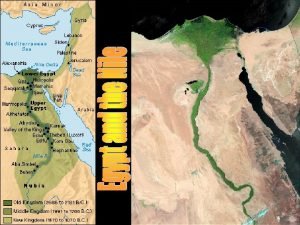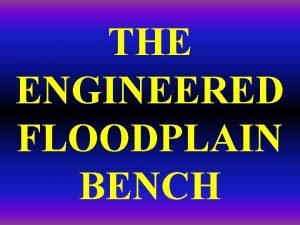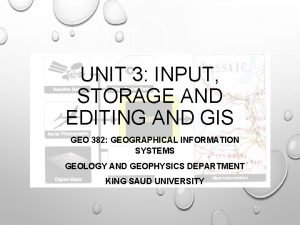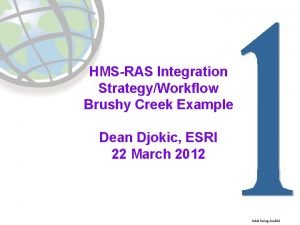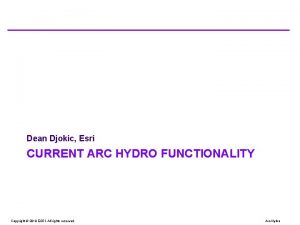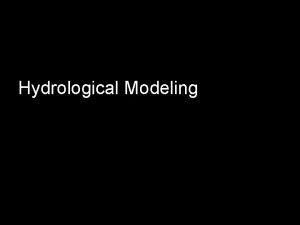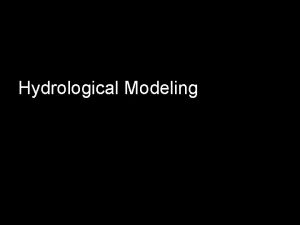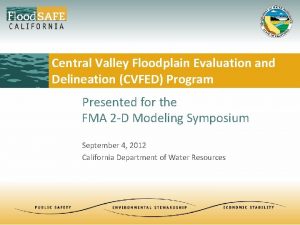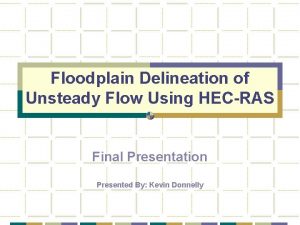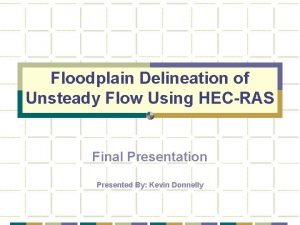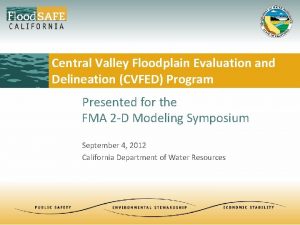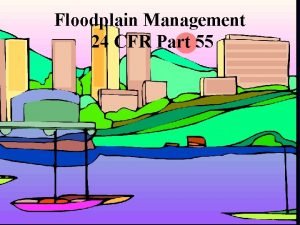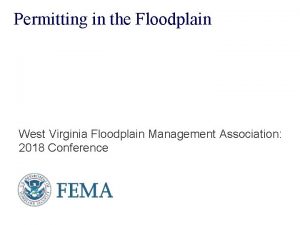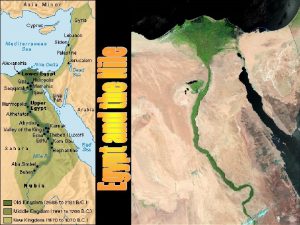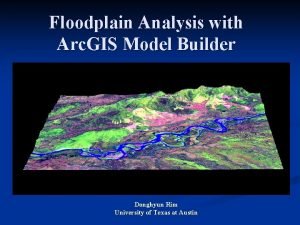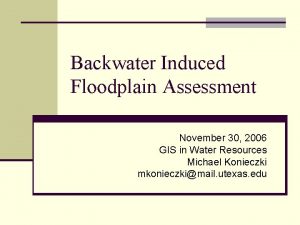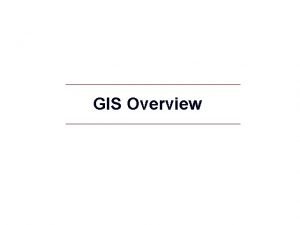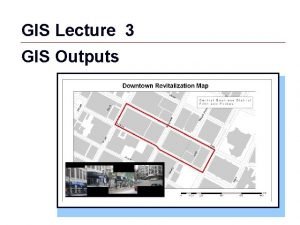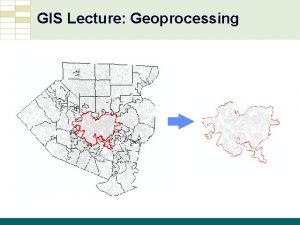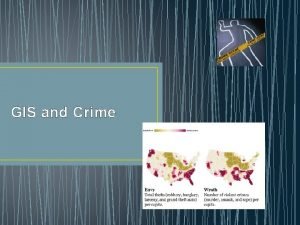GIS Techniques for Floodplain Delineation Dean Djokic ddjokicesri













































































- Slides: 77

GIS Techniques for Floodplain Delineation Dean Djokic (ddjokic@esri. com)

Content • What’s so important about floodplains (and floods) • Principles of GIS floodplain delineation • What can GIS do for floodplain modeling • Methods for GIS floodplain delineation • Flood Tools • Delineation workflows • Comparison of floodplain delineation techniques • Summary • QA GIS Techniques for Floodplain Delineation 2

What’s So Important About Floodplains and Floods

GIS for Floodplain Modeling • What is it all about? “EASY” BUTTON but, there is no “easy” button, just hard work. GIS Techniques for Floodplain Delineation 4

Floodplain Definitions • “To define a floodplain depends somewhat on the goals in mind. As a topographic category it is quite flat and lies adjacent to a stream; geomorphologically, it is a landform composed primarily of unconsolidated depositional material derived from sediments being transported by the related stream; hydrologically, it is best defined as a landform subject to periodic flooding by a parent stream. A combination of these [characteristics] perhaps comprises the essential criteria for defining the floodplain" (Schmudde, 1968). • “Any land area susceptible to being inundated by flood waters from any source” (FEMA). GIS Techniques for Floodplain Delineation 5

Floodplain Definitions GIS Techniques for Floodplain Delineation 6

What’s so Important About Floodplains • 82% of the world’s population lives in areas with high flood risk (UNDP, 2004). Mortality risk is expressed within a decile range with 10 being the most exposed (Decile 10= est. 300 people/sq. km and decile 9 is around 150 people/sq. km). Source: Mark Pelling, Visions of Risk, UNDP / ISDR, 2004 • ¾ of world population lives within coastal zone - • USA – 16. 5 million (5% population) within flood prone coast ½ billion people live within flood prone deltas GIS Techniques for Floodplain Delineation 7

What’s so Important About Floodplains • Recurring - • Lie, bigger lie, statistics Increase in % of aid from Feds due to hurricane/flooding (25% -> 70% since 2005) - Sandy (2 nd most costly), Katrina (1 st most costly) ~ $200 B GIS Techniques for Floodplain Delineation 8

If We Know Where the Floodplain Is … • • Operations - Flood prevention (dam and levee operations) - Emergency management - Facility management Planning - Design - Insurance (not everywhere) - Emergency planning GIS Techniques for Floodplain Delineation 9

Principles of GIS Floodplain Delineation

How to Get the Floodplain • • Observations - Water surface elevations - Flows - Precipitation (rainfall, snow) - “Other” (temperature, soil moisture, E/T, …) Modeling (H&H) - Precipitation-runoff - Real-time - Planning (design) GIS Techniques for Floodplain Delineation 11

Direct Observations (stage/flow) • Traditionally through gaging station - • High water marks - • Problems with sensors during floods Not real time Remote sensing – airborne/satellite - Problem with sensors and cloud cover, cost, timeliness - Some new options with UAVs GIS Techniques for Floodplain Delineation 12

Modeling • How much water is there? - • Where will it go? - • Hydrologic modeling (precipitation-runoff modeling), determines for a given storm on a landscape, how much water will become runoff. Hydraulic modeling takes the quantity of water and the shape of the landscape and stream channel and determines how deep and fast the water will be, and what area it will cover. Types of modeling - Real-time (operations, forecasting) - Long term (planning, design) GIS Techniques for Floodplain Delineation 13

Hydrologic Modeling • Goal: Find stream discharge, Q, at a location for a given precipitation event. • There are many ways to calculate Q. - Statistical methods - - Deterministic/physical modeling (“rainfall/runoff”) - u USGS regression equations (NFF, Stream. Stats) HEC-HMS, SMS, … GIS is used to summarize terrain and hydrologic characteristics of the watershed for input to a model. GIS Techniques for Floodplain Delineation 14

Hydraulic Modeling • Goal: Predict water surface elevations and velocities for a given discharge Q in space and time. • Input: Terrain geometry with hydraulic characteristics, plus discharge Q and initial water surface level. St. Venant equations u GIS is used to summarize terrain and hydraulic characteristics of the channel for input to a model and post process hydraulic modeling results (water surface determination). GIS Techniques for Floodplain Delineation 15

What Do You Need for H&H Analyses • Definition of the landscape - Terrain - Known drainage structures (streams, sinks, lakes) - - Landscape characteristics - • Land use, soils, vegetation cover, … Precipitation - • Constructed elements (dams, channels, tunnels, …) Rainfall, snowfall, temperature, … Boundary conditions - Water levels, soil moisture content, … GIS Techniques for Floodplain Delineation 16

Observations For Modeling (precipitation) • Space and time distribution issues • Traditional rain gages • Nexrad • Satellite • Needs calibration!!!! GIS Techniques for Floodplain Delineation 17

Observations For Modeling (other) • Space and time distribution issues • Needs calibration!!!! Snow pack Groundwater levels Evaporation GIS Techniques for Floodplain Delineation 18

Terrain !!! • Good terrain representation is important for any type of floodplain delineation. • “Good” is a function of the type of modeling being made and type of terrain morphology (flatter terrains need higher accuracy). • “Mapping the Zone”, National Research Council, 2009, National Academies Press, Washington, D. C. , 122 pp. • “Elevation Data for Floodplain Mapping”, National Research Council, 2007, National Academies Press, Washington, D. C. , 152 pp. GIS Techniques for Floodplain Delineation 19

Li. DAR – Beauty and the Beast • Beauty - • High resolution and density Beast - Too much irrelevant data - What are we really measuring? - No explicit breaklines - Processing “art” GIS Techniques for Floodplain Delineation 20

GIS for Floodplain Modeling • So what happened to the “easy” button? “EASY” BUTTON ? GIS Techniques for Floodplain Delineation 21

What Can GIS Do for Floodplain Modeling

What Can GIS Do for Floodplain Modeling? – A LOT! • Centralized data storage • Data preparation for multiple models • Postprocessing of modeling results • Integration of modeling results with other data • Automation of operations (Map to Map) • Mobilizing technology (once results are available): - Emergency management - Notifications - Vehicle routing - … GIS Techniques for Floodplain Delineation 23

GIS Database Development GIS Layers/Data • Develop digital representation of the landscape – one time process. - Quality - Precision - Labor Intensive Rem ote S ensi ng Source: NASA izing igit d p u - s Head Source: NASA GIS Techniques for Floodplain Delineation 24

GIS for Water Resources WQ Floodplain Arc Hydro Permitting GIS Techniques for Floodplain Delineation 25

GIS as Database for Support of Multiple Models • Integrates data formats and model databases into an integrated data and processing system GIS Techniques for Floodplain Delineation 26

We Have the “Blue Blob” – Now What? • Leveraging GIS technology (once the results are available): - Emergency management - Notifications - Vehicle routing/road closures - Evacuation/relief centers - Recovery planning - Permitting - Insurance/risk management - Flood prevention - Design - Policy - … GIS Techniques for Floodplain Delineation 27

Methods for GIS Floodplain Delineation

Floodplain GIS Artifacts • • • Basic result “stack”: - Floodplain extent polygon (the “blue blob”) - Depth of flooding surface (usually raster) - Water surface elevation surface (usually raster) The stack can have two domains: - Temporal (for real-time analysis – e. g. what will the flood extent be today at 16: 00) - Probabilistic (for planning – e. g. what is the 100 -year return period flood extent) Extended “stack” (heavily dependent on the method used): - Velocities - Risks - … GIS Techniques for Floodplain Delineation 29

Methods for GIS Floodplain Delineation • One size does NOT fit all. • Depends on the available data and scope of the analysis. • Anything: • - From basic topographic analysis - To full integration with 2 D/3 D hydraulic models - And anything in between A matrix of solutions and tools that have to be assembled into coherent workflows for specific use cases. GIS Techniques for Floodplain Delineation 30

Floodplain Delineation Solutions Matrix - Simplest • “Flooding out” technique based on DEM only. • Derived stream centerline. • Floodplain stack derived using “flood out” technique for fixed or incremental depth increase along the stream. GIS Techniques for Floodplain Delineation 31

Floodplain Delineation Solutions Matrix - Simple • “Flooding out” technique based on DEM, stream centerline, and point data. • Floodplain stack derived using “flood out” technique for fixed depth, incremental depth, observed measurements, or modeled flows at points with WSE interpolated along the stream. GIS Techniques for Floodplain Delineation 32

Floodplain Delineation Solutions Matrix – Less Simple • “TIN” technique based on DEM, stream centerline, and cross-section data (points are optional). • Floodplain stack derived using “TIN” technique for fixed depth, incremental depth, observed measurements, interpolated, or modeled flows at cross-sections. Cross-sections allow control of lateral distribution of water surface elevations into the floodplain GIS Techniques for Floodplain Delineation 33

Floodplain Delineation Solutions Matrix – Complex • Need H&H models. The complexity in implementation is in derivation of H&H models, not necessarily in floodplain delineation based on the model results. • Some of the floodplain delineation is the same as in previous examples, once the model results are imported into GIS. - • • Some require a combination of approaches (e. g. ICPR 3) More complex: - 1 -D hydraulic modeling in operational mode (complexity in data collection) - 1 -D hydraulic modeling in design mode (for fixed flood frequency – design discharges derived using statistical methods) - 1 -D hydraulic modeling in design mode (for fixed flood frequency – design discharges derived using deterministic methods) Most complex: - Fully integrated 2 -D hydrologic and hydraulic modeling GIS Techniques for Floodplain Delineation 34

“Flood Out” Technique • This technique can be used when reliable cross-sections are not available. • Use the water surface elevation along the stream line and “push out” that elevation away from the stream. • Neighboring cells get the WSE of the nearest cell along the stream. • Uses Spatial Analyst nibble function. • Technique first builds an unrestricted WSE “water” surface ignoring the presence of the terrain. • Then the difference between the water WSE and terrain elevation is taken and all negative values are eliminated. This defines the depth of flooding. • The extent of depth of flooding is converted to a polygon and that defines the floodplain polygon in the flood stack. GIS Techniques for Floodplain Delineation 35

“TIN” Technique • This technique can be used when reliable cross-sections are available. • Use cross-sections as hard breaklines with water surface elevation as values. Build a TIN using the stream and cross-sections. • The “water” TIN is limited only by the extent of the cross-sections (ignoring the presence of the terrain). • Water TIN is converted into raster of same resolution as DEM. • Then the difference between the water WSE and terrain elevation is taken and all negative values are eliminated. This defines the depth of flooding. • The extent of depth of flooding is converted to a polygon and that defines the floodplain polygon in the flood stack. GIS Techniques for Floodplain Delineation 36

WSE Longitudinal Interpolation Technique • Often, WSE is know at few (sometimes none) points along the stream (based on observed or modeled locations). • Special tool to perform linear interpolation of WSE along the stream line (“Create 3 D Stream WSE Line” and “Create 3 D WSE Stream Line Grid”). • Interpolation is performed linearly between points with known WSE on a reach by reach basis. • Special cases for dealing with: - No points on the reach - One point on the reach - Confluences (adjustment or no adjustment of WSE from connected streams) GIS Techniques for Floodplain Delineation 37

Custom Solutions: Leverage Existing Model Interfaces • Many H&H models have GIS interfaces that can be used to generate the floodplain stack. • Always use these interfaces if at all possible. • Maintaining custom model interfaces is a “never ending” job – have someone else do it – it is worth every $. GIS Techniques for Floodplain Delineation 38

“Flood” Tools (Arc Hydro)

Tools Purpose • • • Support for floodplain analysis - Real-time (observed, forecasted flows) - Planning (flood frequency) Facilitate landscape characterization for floodplain analysis - Streams - Cross-sections - Floodplain delineation - Points - Cross-sections - Models GIS Techniques for Floodplain Delineation 40

Real-time Observations • Leverage Water. ML 1. 1 and 2. 0 standards • Arc Hydro Water. ML time series download tool - Populate standard Arc Hydro time series tables GIS Techniques for Floodplain Delineation 41

Landscape Characterization for Hydraulic Analysis • • • Streams - DEM alignment and thalweg adjustment - Longitudinal WSE interpolation based on point values Cross-sections - Characterization: h, A, B, P, R curve - Synthetic rating curve (based on normal depth with n and S 0 assumption) - WSE Interpolation Floodplain (for incremental or specific stages) - Depth of flooding - Water surface elevations - Flood extent GIS Techniques for Floodplain Delineation 42

Floodplain Delineation • Points (“flood out” technique) - • Cross-sections (TIN technique) - • WSE at points along streams (observed, modeled through Q) WSE at cross-sections (observed, modeled through Q) Models - 1 D (HEC-RAS, ICPR 3) - 2 D (ICPR 4) GIS Techniques for Floodplain Delineation 43

Arc Hydro Tools • Organized in several AH toolsets (most in “H & H Modeling” and “Utility”) • ~ 35 tools GIS Techniques for Floodplain Delineation 44

Delineation Workflows

Process Implementation • Workflows for piecing solutions together as a function of available input data • Increasing complexity of possible solutions as a function of data availability: • - Minimal (DEM only) - Medium (DEM and some additional data) - Full (GIS + H&H modeling) - … and anything in-between Comprehensive process documentation in initial phase - Matrix of use cases - Workflows and tools to support them - Similar to terrain processing doc GIS Techniques for Floodplain Delineation 46

Sample Implementation Use Cases • • DEM only: - Create synthetic streams from DEM - “Flood out” WSE along streams in incremental steps DEM + cross-sections: - • DEM + stream + observed points: - • Use TIN technique for WSE at c-s in incremental steps “Flood out” observed WSE along streams DEM + stream + modeled Q at points: - Build c-s and develop synthetic rating curve at modeled points - Use synthetic rating curve to get WSE from modeled Q - Alt 1 – use flood out technique at points - Alt 2 – use TIN technique at c-s GIS Techniques for Floodplain Delineation 47

Comparison of Floodplain Delineation Techniques

Methodology • Tuolumine River – Modesto, CA • Fully developed RAS model (Baxter) • 50 -year event • Benchmark are depths developed through Geo. RAS postprocessing • Comparison with “flood out” technique - Take WSE developed at CS by RAS - Assign them to points on the stream where CS intersects the stream - Use the “flood out” technique to get the floodplain/depths - Calculate difference between Geo. RAS and “flood out” depths - Incrementally reduce the number of points (“all”, “some”, “ 2”, “ 1 up”, “ 1 dwn”) GIS Techniques for Floodplain Delineation 49

Area of Interest GIS Techniques for Floodplain Delineation 50

Area of Interest GIS Techniques for Floodplain Delineation 51

Area of Interest GIS Techniques for Floodplain Delineation 52

Geo. RAS Inundation Depths (ft) GIS Techniques for Floodplain Delineation 53

Geo. RAS – “all” Difference (ft) GIS Techniques for Floodplain Delineation 54

Geo. RAS – “some” Difference (ft) GIS Techniques for Floodplain Delineation 55

Geo. RAS – “ 2” Difference (ft) GIS Techniques for Floodplain Delineation 56

Geo. RAS – “ 1 up” Difference (ft) GIS Techniques for Floodplain Delineation 57

Geo. RAS – “ 1 dwn” Difference (ft) GIS Techniques for Floodplain Delineation 58

Side-by-side Comparison Geo. RAS Depth Geo. RAS – “ 2” diff GIS Techniques for Floodplain Delineation 59 Geo. RAS – “all” diff Geo. RAS – “some” diff Geo. RAS – “ 1 up” diff Geo. RAS – “ 1 dwn” diff

Summary

Summary • GIS has many tools to facilitate floodplain delineation • Data are the key to quality results • While the GIS tools are “easy” to use, it is also “easy” to produce non-sensical results • Ability to “see” results enable easier quality control • GIS as framework for automation of complex floodplain analyses • Easy mobilization of GIS technology once the “blue blob” is obtained GIS Techniques for Floodplain Delineation 61

Floodplain Discontinuity GIS Techniques for Floodplain Delineation 62

Floodplain Discontinuity (cont. ) “Dry” Water surface profile Terrain Cross sections GIS Techniques for Floodplain Delineation 63

Cross-Section Interpolation TIN-interpolated cross sections RAS-assumed terrain Original cross sections GIS Techniques for Floodplain Delineation 64 Terrain

Summary • GIS as framework for automation of complex floodplain analyses GIS Techniques for Floodplain Delineation 65

Map To Map to Automate Rainfall-Runoff-Flood Modeling • Complex Alterative Evaluations • Climate Change • Landuse Development • - Deforestation - Urbanization - … Real-time operations - Check out NFIE presentation on Thursday GIS Techniques for Floodplain Delineation 66

Summary • Easy mobilization of GIS technology once the “blue blob” is obtained GIS Techniques for Floodplain Delineation 67

Impact Summary App: This web application highlights an area and displays a summary of data related to its location. Areas can be enriched with demographic, infrastructure, or landscape data to later be analyzed and shared. The map is dynamic and interactive to provide real time situational updates. In the example above, the inundation levels have been enriched with population data of those who are over 65, living under the poverty line, or lacking access to transportation.

Public Information App: This web app is fully configurable for public facing maps that allows authoritative data feeds to be shared to the public. In this example, road closures, evacuation routes, points of interest, low water crossings, and bridges are all shown for public information sharing. Emergency shelters can also be added to the map as they open to inform the public on where to seek help.

Social Media App: This web application provides configurable templates to display geolocated content from Flickr, Youtube, and Twitter. Resulting content can be analyzed as clusters or heat maps. This app is also configurable with emergency alert systems or emergency assistance registries. Also displayed in this example, are low water crossings evacuation routes and bridges within the effected area.

Map Comparison App: This application allows the examination of 3 web maps simultaneously to detect changes or relationships. This app is useful to display data over time to visualize changes and patterns in the data. This example shows how the inundation levels of the creek change over time based on predicative modeling.

3 D Viewer Esri City. Engine: This modeling software allows the transformation of 2 D GIS Data into interactive 3 D Models. The example above shows the October flooding at multiple levels in the Onion Creek Area. This model also allows for the assessment of infrastructure damage and potential areas in need of emergency response.

3 D Viewer Esri City. Engine: The example above shows water depths for the 100 -year and 25 -year flooding events in relation to people and buildings.

Flood Response Run Book: Along with web maps and apps, Flood Response Run Books can also be created to provide hard copy references to emergency responders in the field. In this example, the area is divided by UTM Gridlines. It is also possible to split the area by emergency response zones and by right and left side of the river. These pages would be indexed to critical infrastructure in each grid along with streets and points of interest.

GIS for Floodplain Modeling • Maybe not “easy” yet, but it isn’t mystery. “EASY” BUTTON GIS Techniques for Floodplain Delineation 75

Thank You… • Questions? • Please fill out the session survey in your mobile app • Select “GIS Techniques for Floodplain Modeling” in the Mobile App - Use the Search Feature to quickly find this title • Click “Technical Workshop Survey” • Answer a few short questions and enter any comments GIS Techniques for Floodplain Delineation 76

 Hydro
Hydro Dean djokic
Dean djokic Dean djokic
Dean djokic Delineation techniques of a region
Delineation techniques of a region Dean d dean
Dean d dean Contour map watershed delineation
Contour map watershed delineation Watershed delineation pdf
Watershed delineation pdf How is a floodplain formed
How is a floodplain formed Floodplain zoning advantages and disadvantages
Floodplain zoning advantages and disadvantages Source zone transition zone and floodplain zone
Source zone transition zone and floodplain zone Is a meander constructive or destructive
Is a meander constructive or destructive Nile floodplain
Nile floodplain Parishes of the mississippi floodplain region
Parishes of the mississippi floodplain region Nile floodplain
Nile floodplain Mesopotamia floodplain
Mesopotamia floodplain Lpstp
Lpstp Gis data input
Gis data input Fonctions techniques et solutions techniques
Fonctions techniques et solutions techniques Vad är referatmarkeringar
Vad är referatmarkeringar Karttecken
Karttecken Mjälthilus
Mjälthilus Rådet för byggkompetens
Rådet för byggkompetens Formel för lufttryck
Formel för lufttryck Avrunda decimaltal
Avrunda decimaltal Underlag för särskild löneskatt på pensionskostnader
Underlag för särskild löneskatt på pensionskostnader Elektronik för barn
Elektronik för barn Borra hål för knoppar
Borra hål för knoppar Smärtskolan kunskap för livet
Smärtskolan kunskap för livet Bris för vuxna
Bris för vuxna Trög för kemist
Trög för kemist Jiddisch
Jiddisch Ellika andolf
Ellika andolf Datorkunskap för nybörjare
Datorkunskap för nybörjare För och nackdelar med firo
För och nackdelar med firo Blomman för dagen drog
Blomman för dagen drog Returpilarna
Returpilarna Steg för steg rita
Steg för steg rita Redogör för vad psykologi är
Redogör för vad psykologi är Gumman cirkel sång
Gumman cirkel sång Bästa kameran för astrofoto
Bästa kameran för astrofoto Mat för idrottare
Mat för idrottare Ledarskapsteorier
Ledarskapsteorier Publik sektor
Publik sektor Cirkelkomposition dikt
Cirkelkomposition dikt Vilotidsbok
Vilotidsbok Fredsgudinna pax
Fredsgudinna pax Formuö
Formuö Orubbliga rättigheter
Orubbliga rättigheter Ministerstyre för och nackdelar
Ministerstyre för och nackdelar Bamse för de yngsta
Bamse för de yngsta Kanaans land
Kanaans land Sju principer för tillitsbaserad styrning
Sju principer för tillitsbaserad styrning Nyckelkompetenser för livslångt lärande
Nyckelkompetenser för livslångt lärande Romarriket tidslinje
Romarriket tidslinje Tack för att ni lyssnade bild
Tack för att ni lyssnade bild Datumr
Datumr Varför kallas perioden 1918-1939 för mellankrigstiden?
Varför kallas perioden 1918-1939 för mellankrigstiden? Borstål, egenskaper
Borstål, egenskaper Verktyg för automatisering av utbetalningar
Verktyg för automatisering av utbetalningar Vishnuiter
Vishnuiter Centrum för kunskap och säkerhet
Centrum för kunskap och säkerhet Vad är hsil
Vad är hsil Lyckans minut erik lindorm analys
Lyckans minut erik lindorm analys Inköpsprocessen steg för steg
Inköpsprocessen steg för steg A gastrica
A gastrica Strategi för svensk viltförvaltning
Strategi för svensk viltförvaltning Vad är verksamhetsanalys
Vad är verksamhetsanalys Typiska novell drag
Typiska novell drag Stickprovsvariansen
Stickprovsvariansen Tack för att ni har lyssnat
Tack för att ni har lyssnat Klassificeringsstruktur för kommunala verksamheter
Klassificeringsstruktur för kommunala verksamheter Läkarutlåtande för livränta
Läkarutlåtande för livränta Påbyggnader för flakfordon
Påbyggnader för flakfordon Tack för att ni lyssnade
Tack för att ni lyssnade Egg för emanuel
Egg för emanuel En lathund för arbete med kontinuitetshantering
En lathund för arbete med kontinuitetshantering Atmosfr
Atmosfr Rutin för avvikelsehantering
Rutin för avvikelsehantering
